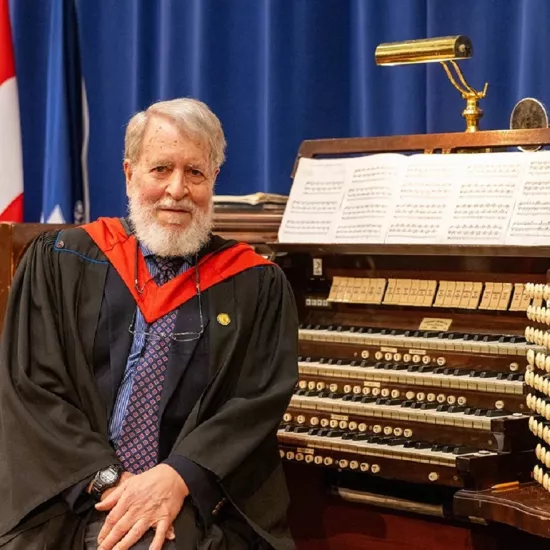Eminent Canadian astronomer illuminates the science and wonder of comets

Whether as objects of scientific study or as fascinating sights in the night sky, comets have long captured the human imagination. Last Friday, the nature, history and magic of these heavenly messengers was highlighted at a University of Toronto Mississauga talk by world-renowned Canadian astronomer David H. Levy.
At "A Nightwatchman’s Journey: Adventures As A Comet Discoverer and Skywatcher", the Montreal native shares his extensive insights and unique experiences from almost five decades of studying and educating others about comets and the cosmos. The lecture also included the opportunity to view the night sky with telescopes provided by the Royal Astronomical Society of Canada, the event sponsor.
“Just as a night watchman patrols a building to make sure things are safe and secure, I patrol the night sky,” says Levy, who lives and works in Vail, AZ. “The sky is not a static thing, it’s something that’s always changing, and you never know what’s going to surprise you. Comets could appear anywhere in the night sky.”
And Levy seems to have a knack for discovering them—since first taking up the pursuit in 1965, he has observed 22 comets, including nine with a telescope in his own backyard. Perhaps his most famous find took place in 1994 at the Palomar Observatory in California when, along with the planetary scientists Eugene and Carolyn Shoemaker, he witnessed a comet collide with the planet Jupiter. Shoemaker-Levy 9, as it became known, produced one of the most sensational explosions ever witnessed in the solar system.
“A comet is really a gift from nature,” Levy says. “Shoemaker-Levy 9 had a profound impact on me. I woke up the next morning and said to myself, ‘Now I know how Clyde Tombaugh felt when he discovered Pluto.’”
Levy first became enchanted with the celestial world in 1959 when, as an 11-year-old boy, he saw his first partial eclipse of the sun. Since then, he has devoted his life to studying comets, and usually spends at least an hour each day watching the skies at pre-dawn with the 14 telescopes at his home observatory. Levy’s investigations into space have also led him to discover more than 150 asteroids.
For Levy, sharing his comet-hunting experiences with the world is equally enjoyable and important work. He has authored or edited 31 books and other publications about the subject; helped write the Discovery Channel documentary “Three Minutes to Impact”, which earned him an Emmy Award; and has edited and written for multiple science and astronomy magazines. As well, he has given hundreds of lectures and media interviews on astronomy and, together with his wife Wendee, a partner in his astronomy work, hosts the weekly Internet radio show Let’s Talk Stars.
Levy is also the founder of Sharing the Sky Foundation, a non-profit that aims to increase public interest in astronomy and science, especially among youths. The organization delivers classroom presentations and leads observations at local schools, and holds annual sky-watching retreats in New York’s Adirondack Mountains.
For Levy, searching for comets is far from strictly a scientific endeavour; these cosmic snowballs of frozen gases, dust and rock continue to inspire wonder and awe in the 65-year-old. His perspective on astronomy is influenced by his three English degrees—a BA from Acadia University in Nova Scotia, an MA from Queen’s University in Ontario, and a PhD from Hebrew University of Jerusalem. At the last institution, he weaved his passion for the cosmos into his dissertation, which was called “The Sky in Early Modern English Literature: A Study of Allusions to Celestial Events in Elizabethan and Jacobean Writing, 1572-1610.”
Says Levy: “Astronomy itself is an interesting science, but the passion for me is the poetic aspect. We just want to figure out what’s happening out there.”



